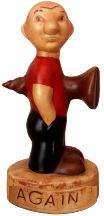 |
 The Virtual Corkscrew Museum's Weekly Newspaper |
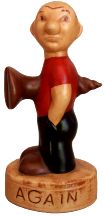 |
 |
 The Virtual Corkscrew Museum's Weekly Newspaper |
 |
|
Sunday, April 19, 2009 |
Number 553 |
Dewey's Slug
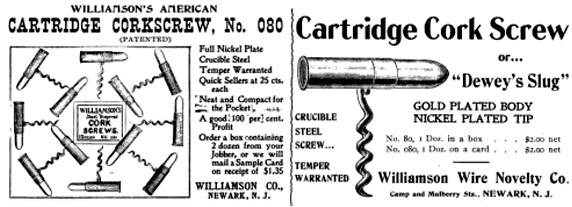
Williamson advertisements from 1899 issues of the The House Furnishing Review.
On January 11, 1897 William A. Williamson filed an application for a patent for his invention of a corkscrew which is concealed inside a small bottle shape. The ends thread together and when unscrewed, a helix pivots at an angle to the base. The two pieces are then screwed back together to form the handle. The bottle had already been introduced in 1893 at the Chicago Columbian Exposition as a souvenir. In the ensuing years, a number of breweries, distillers, cafes, etc. used the bottle as a promotional item. On June 1, 1897, U. S. Patent #583,561 was issued.
In 1899 Williamson introduced the "Cartridge Corkscrew" or "Dewey's Slug" using the same functional design as the bottle. The "Slug" is in the shape of a
cannon projectile. The "Slug" was most likely introduced in celebration of the end of the Spanish-American war and to commemorate the capture of the "Dewey Cannon."
The Spanish-American war had begun with the 1898 sinking of the USS Maine in the Havana, Cuba harbor ("Remember the Maine"). Blaming fingers were pointed at the Cubans and the Spanish by Americans while Spanish and loyalist Cuban opinions theorized that the U. S. government may have caused the sinking to go to war with Spain. The U. S. declared war on Spain on April 25, 1898. The first battle took place at Manila Bay in the Philippines on May 1, 1898 with Commodore George Dewey (1837-1917) commanding the U. S. Navy's Pacific fleet. The war was very short with fighting ending on August 12, 1898 and a treaty was signed on December 10, 1898.
The story of the "Dewey Cannon" was reported in the media as "The Filipinos captured the gun from Spaniards who were throwing up earthworks on Corregidor Island, preparatory to use against the United States forces. The cannon was taken aboard the United States revenue cutter McCulloch and Commodore Dewey - for he was not an admiral then - decided to give it to the national monument committee as his contribution to the monument fund provided for the erection of a suitable monument to the martyrs of the battleship Maine and the soldiers and sailors of the Spanish-American war."
From The House Furnishing Review published by I. B. Scott, January, 1899.
The Williamson Company, Newark, N.J. are putting upon the market their newly patented Cartridge Corkscrew called "Dewey's Slug," shown by the accompanying cuts. This pocket Corkscrew makes one of the most useful, durable and saleable articles now on the market, being, as it is, an appropriate souvenir of the times. The upper portion, or tip of the cartridge, is finished in nickel plate, the lower portion is a light bright copper shape, while the corkscrew is heavily nickeled. The "Dewey Slug" makes a decidedly up-to-date novelty, and sells readily for twenty-five cents, giving good profit to the retailer.
Here are two Dewey Slugs marked with the 1897 Williamson patent date. One is "Compliments of Pittsburg Bridge Company" and the other advertises Old Crow Whiskey.
The large Dewey slugs on the left and the right are marked with the 1897 date. The one on the right is silver. The third and fourth also have 1897 marks and are from The Turner Looker Co. of Cincinnati and the Lemp Brewery of St. Louis. Looking closely at the 2nd, 3rd, and 5th slug, the reader can see a difference in the very bottom (rimless). These three are the 1900 patent of Ralph Jorres. On September 4, 1900 Ralph W. Jorres was granted U.S. Patent #657,421 for his version of the Williamson corkscrew. Jorres attached the helix to the top of the bottle/bullet instead of the base.
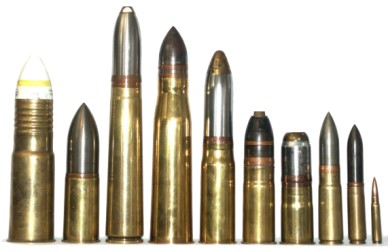
Cannon Cartridges
On July 16, 1899, the Michigan town of Three Oaks celebrated the installation of the "Dewey cannon" a parade, patriotic speeches, fireworks, and special electrical decorated lighting. The cannon was awarded to the town by Admiral Dewey for raising the most money per capita for the USS Maine memorial monument fund. The cannon's installation in Three Oaks was officially dedicated on October 10, 1899 by President William McKinley. The official unveiling, however, was planned for 1900 in hopes that Admiral Dewey would attend.
In early May, 1900, Three Oaks received news that Admiral Dewey would visit the town. At the end of May, Dewey announced that he would not attend. The unveiling date was then set for June 28, 1900 with the guest of honor being Helen Miller Gould, daughter of financier Jay Gould, a nurse during the Spanish-American War, and a major contributor to the Spanish-American war campaign.
June 28, 1900 - Unveiling of the cannon
The Boy Mechanic
The Boy Mechanic was published from 1913-1952 by Popular Mechanics magazine. Reader Ron MacLean found these cork removing ideas in issues of the magazine.
Non-Vital Organs
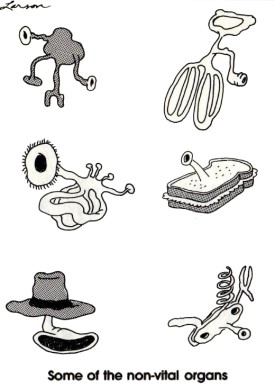
Cartoon by Gary Larson submitted by Ron MacLean
Corkscrew Posts
Editor's Note: In the June 24, 2007 and July 8, 2007 issues we reported on various outdoor corkscrews including one reportedly used by the U. S. Cavalry in the 19th Century. This article appeared in the September 8, 1916 edition of The Cranbury Press (New Jersey).
IRON POSTS SUPPORT WIRE
German Idea That Makes Their Trenches Only a Little Way From Being Impregnable
In the Atlantic Monthly Mr. Edward Morine describes a very clever improvement the Germans have made in their barbed-wire defenses. The wires are usually fastened to wooden posts, of course, but the Germans have found a better support for them. He writes:
"After we had taken the German trench, our men set to work to remodel it, shifting the parapet to the other side, building little outpost trenches and setting barbed wire. The latter job was done in a wonderfully short time, thanks to German thoroughness. For the wood stakes to which the wire is tied they had substituted soft iron rods, three-quarters of an inch thick, twisted five times in the shape of a great corkscrew. This screw twisted into the ground exactly like a corkpuller into a cork. The straight part of the rod, being twisted upon itself down and up again every ten inches, formed six or seven small loops in a height of about five feet. Into these eyes the barbed wire was laid and solidly secured with short lengths of tying wire.
"First cutting the tying wire, we lifted the barbed wire out of the eyes, shoved a small stick through one, and, turning the rod with leverage of the stick, unscrewed it out of the ground, and then, reversing the process, screwed it in again. The advantage of this rod is obvious. When a shell falls in the midst of this wire protection, the rods are bent and twisted, but unless broken off short they always support the wire, and even after a severe bombardment present a serious obstacle to the assaulters. In such case wooden posts are blown to smithereens by the shells, and when broken off they let the wire fall flat to the ground."
Did the Germans get the idea from the U. S. Cavalry posts of the 19th Century?
Anne Luchsinger
Anne and Paul Luchsinger hosted the 2008 meeting of the International Correspondence of Corkscrew Addicts (ICCA) in Williamsburg, Virginia. Attendees were greeted by Anne and a giant "corkscrew". Paul acquired the "fence post" about 7 years ago from a seller in South Dakota and had a craftsman in Western Pennsylvania create the appropiate handle.
|
©2009 Don Bull, Editor |